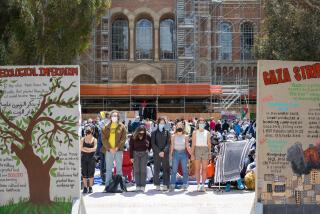Danger: Historians at Work : HISTORY WARS: The Enola Gay and Other Battles for the American Past.<i> Edited by Edward T. Linenthal and Tom Engelhardt (Metropolitan Books: $30, 291 pps.)</i>
- Share via
Commemorations, remembrances, memorials. Such innocent sounding words, yet nothing these days is so fraught with tension and anxiety, so likely to produce discord, as any effort to reconstruct the American past in the public realm. Still, the historic celebrations have kept coming--centenaries of historic Civil War battlefields were followed by the 1976 bicentennial of the American revolution, the quincentenary of Columbus’ voyage, the 250th anniversary of Thomas Jefferson’s birthday, and on to the 50th anniversaries of D-day, V-E day and V-J day that brought World War II to a close.
As its title “History Wars: The Enola Gay and Other Battles for the American Past” indicates, the conflicts over American commemorations have moved into open warfare recently. They were ratcheted up by the furor last year over a projected exhibit at the Smithsonian Institution’s National Air and Space Museum about the Enola Gay, the B-29 Superfortress that dropped the first atomic bomb on Japan, 51 years ago this week. It’s hard to believe that history, a subject that has managed to bore an endless stream of 11th graders, continues to be one of the hottest topics around. Why now--and why history?
Part of the answer lies with the double-edged sword of commemorations: It takes two to make one. In the first place, there’s a group seeking to celebrate a place, event or artifact, like the fuselage of a historic B-29. Members of the group are often the guardians of the relic and they frequently raise the money to hold the commemoration ceremonies in the first place.
But they need experts to pull it off--historians and curators whose job it is to recover the history of the event being memorialized. Mixed together, these two groups can produce an explosion, because they bring different goals to the project. That’s exactly what happened when the Smithsonian began planning its 1995 exhibit with the Enola Gay as an emblem of both America’s military might and the unlocking of the atom’s destructive power.
On one side were members of the Air Force Assn., composed of retired and active Air Force personnel and their industrial supporters. They considered the atomic climax to World War II to be an American triumph and had an unflinching conviction of what the exhibit should be.
On the other side were curators, scholars and advisors steeped in the scholarship of World War II and its chilly aftermath. Theirs was a more troubled and ambiguous view. To reconstruct such events with fidelity and comprehensiveness gave them a splendid chance to reach a public whose indifference to the past is best captured in the dismissive phrase, “That’s history.” The stage was set--and where better to discuss the ironic coupling of sweet victory and mass destruction than on the Washington, D.C., Mall in the most visited museum in the world?
Predictably, one group detonated the other, as the eight essays in this collection so compellingly explain. “History Wars” follows the political ruckus with fascinating details as it reverberated through veterans groups, museum curators associations, universities, Congress and the media. Yet it’s not as if these conflicts hadn’t surfaced before.
The Japanese have only recently begun to discuss publicly such sensitive subjects as their brutal invasion of Nanking, the Pearl Harbor attack, the wartime impressment of Korean “comfort women” and the Bataan march. In the United Sates, meanwhile, President Harry S. Truman’s decision to use atomic weapons on a largely civilian population has been debated endlessly since 1945, notwithstanding its role in bringing the Pacific war to an immediate end.
Questions abound: Could there have been a demonstration of the bomb’s force in a deserted place, so the Japanese could have seen what they were up against? Did the United States ignore Japanese peace initiatives? Would the weapon have been dropped on a European country? Were civilians massacred to send a gruesome message to the Soviet Union about U.S. military might? And why a second bomb three days later on Nagasaki?
There has also been speculation about the military casualties that America would have experienced if it hadn’t dropped the bomb and instead mounted a land invasion of Japan. Scholarly debate over Hiroshima and Nagasaki has never stopped--yet what role was this distinguished record of sober analysis to play in an exhibit that commemorated the 50th anniversary of the Enola Gay’s awesome mission? “None,” answered a chorus of angry veterans, among them Gen. Paul Tibbets, who piloted the plane that ushered in the atomic age.
In the end, money talked. Irate congressmen threatened the Smithsonian’s budget, and the institution’s new secretary, Michael Heyman, formerly chancellor of UC Berkeley, scaled back the exhibit to the unelaborated display of the Enola Gay’s fuselage, which the museum had spent millions of dollars spiffing up. A series of exhibition “scripts” that tried to find common ground between the two sides were abandoned.
Focusing on the higher goal of making sense of one of the great battles over the American past, the writers of “History Wars” do not engage directly with the aging veterans and their young allies on the right, the cultural warriors of the ‘90s. What the authors explicate with passion and precision are the deep ambiguities involved in discussing a war that, once and for all, shredded the illusion that there were some things in this world that warring nations wouldn’t or couldn’t do.
Edited by Edward T. Linenthal and Tom Engelhardt, whose fine essays frame the book, “History Wars” delivers far more than battle reports. Clearly representing the “experts’ ” side of the case, its essays unpack the meaning in each round of the escalating controversy. Richard H. Kohn’s “History at Risk: The Case of the Enola Gay” teases out five different historical trends that converged after the congressional elections of 1994 swept the exhibit’s most powerful critics into office. Perhaps because he is a former U.S. Air Force historian, Kohn is willing to plunge beneath the surface of the offending scripts and imagine why their likely effect upon viewers might have alarmed veterans of World War II.
In a particularly powerful essay, historian John Dower writes that fulminations about historical revisionism and elite deconstructionists trivialize the serious issues involved here, for “the lifeblood of democracy itself . . . lies in tolerance of principled criticism, a constant willingness to entertain serious challenges to entrenched and orthodox views.”
Just what turned the Enola Gay into a national icon arouses the curiosity of Linenthal, while Marilyn B. Young, a Vietnam War historian, reminds us that the impact of any historical event will always be filtered through multiple retrospective lenses. Her title, “Dangerous History: Vietnam and the Good War,” captures her message. Less concerned with the dropping of the atomic bomb than with assessing the 1995 exhibit’s bombshell, U.S. historian Mike Wallace places the conflict in the context of cultural wars swirling around the teaching of “historical standards” and disputes like those over Columbus’ “discovery” of the New World. In a fitting close to this surprisingly compelling collection, Engelhardt’s “The Victors and the Vanquished” reminds us that the mystic chords of memory are just as likely to produce cacophony as harmony.
To their great credit, World War II leaders like Gen. Dwight D. Eisenhower and Adm. William Leahy recoiled in horror at the effects of the atomic power they had unleashed. Does that mean that they thought the attacks on Hiroshima and Nagasaki were unjustified? Probably not. But it reveals their profound awareness that choices in life are often made between the bad and the worse.
To grasp the drama of last year’s Enola Gay controversy, one has to envision a world that simultaneously contains American soldiers ecstatic that their young lives are no longer at risk--and a world where Japanese children are incinerated as they walk to school through the streets of Hiroshima and Nagasaki. Wars do not provide hermetically sealed compartments for one’s own personal experiences, and the fate of survivors sometimes rests upon explaining how both of these realities can exist at the same time.
As the Smithsonian controversy shows, Americans are sometimes all too human in the desire to have their cake and eat it, too. Inordinately proud of their traditions of free speech, they nonetheless wish fervently that, by exerting social pressure, they could suppress unpleasant discussions. And they are not alone: While words flew thick and fast over the Enola Gay in Washington last year, veterans in Nagasaki formed the Citizens Assn. to Rectify the Nagasaki Atomic Bomb Museum. They wanted to cleanse the museum’s exhibit of any untoward pictures of Japanese aggression, lest future generations come to believe that the United States had dropped the atomic bomb because Japan had done something wrong.
The past is indeed up for grabs on both sides of the Pacific. Yet “History Wars’ ” gripping retelling of this controversy over a controversy leaves the impression that the experts will probably have the last word--mainly because they have so many good ones.
More to Read
The biggest entertainment stories
Get our big stories about Hollywood, film, television, music, arts, culture and more right in your inbox as soon as they publish.
You may occasionally receive promotional content from the Los Angeles Times.










